高三英语时态复习
高中英语时态总结
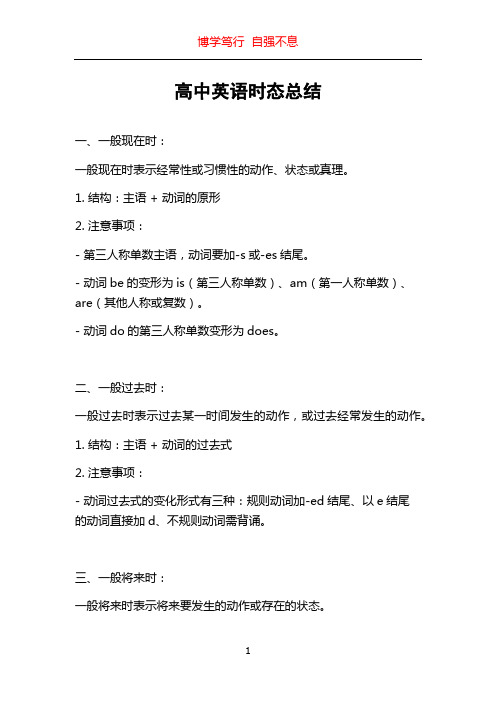
高中英语时态总结一、一般现在时:一般现在时表示经常性或习惯性的动作、状态或真理。
1. 结构:主语 + 动词的原形2. 注意事项:- 第三人称单数主语,动词要加-s或-es结尾。
- 动词be的变形为is(第三人称单数)、am(第一人称单数)、are(其他人称或复数)。
- 动词do的第三人称单数变形为does。
二、一般过去时:一般过去时表示过去某一时间发生的动作,或过去经常发生的动作。
1. 结构:主语 + 动词的过去式2. 注意事项:- 动词过去式的变化形式有三种:规则动词加-ed结尾、以e结尾的动词直接加d、不规则动词需背诵。
三、一般将来时:一般将来时表示将来要发生的动作或存在的状态。
1. 结构:主语 + will + 动词的原形2. 注意事项:- 当主语为第一人称时,可用shall代替will。
- 当表示将来的时间副词或状语连用时,将来时常和动词的原形连用。
四、现在进行时:现在进行时表示现在正在发生的动作。
1. 结构:主语 + am/is/are + 动词的ing形式2. 注意事项:- 动词-ing形式的构成规则为动词原形结尾加-ing。
- 动词末尾的e需去掉,再加-ing。
- 重读闭音节,末尾只有一个辅音字母时,应将末尾辅音字母双写,再加-ing。
五、过去进行时:过去进行时表示过去某一时间正在进行的动作。
1. 结构:主语 + was/were + 动词的ing形式2. 注意事项:- 动词-ing形式的构成规则同现在进行时。
- 句中使用过去进行时时,一般还需要使用表状态动词的动词-ing 形式。
六、将来进行时:将来进行时表示将来某一时间正在进行的动作。
1. 结构:主语 + will be + 动词的ing形式2. 注意事项:- 动词-ing形式的构成规则同现在进行时。
七、一般过去将来时:一般过去将来时表示过去的某个过去时间点本来要发生的事情,但实际上未发生。
1. 结构:主语 + would + 动词的原形2. 注意事项:- would在句中只表示动词的一种形式,无人称和数的变化。
高考英语必背知识点及常考点大全
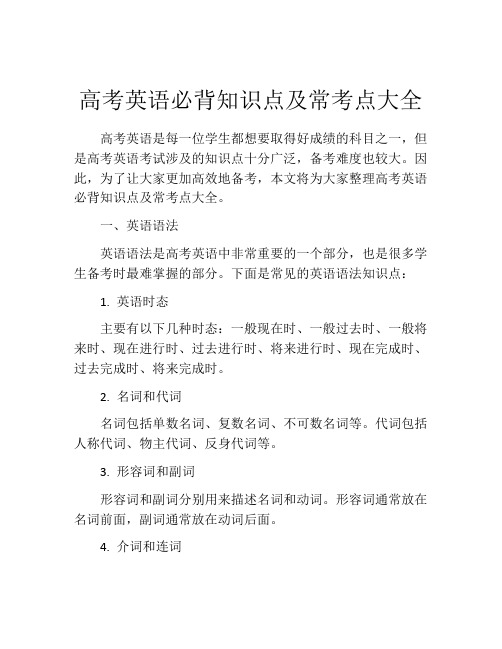
高考英语必背知识点及常考点大全高考英语是每一位学生都想要取得好成绩的科目之一,但是高考英语考试涉及的知识点十分广泛,备考难度也较大。
因此,为了让大家更加高效地备考,本文将为大家整理高考英语必背知识点及常考点大全。
一、英语语法英语语法是高考英语中非常重要的一个部分,也是很多学生备考时最难掌握的部分。
下面是常见的英语语法知识点:1. 英语时态主要有以下几种时态:一般现在时、一般过去时、一般将来时、现在进行时、过去进行时、将来进行时、现在完成时、过去完成时、将来完成时。
2. 名词和代词名词包括单数名词、复数名词、不可数名词等。
代词包括人称代词、物主代词、反身代词等。
3. 形容词和副词形容词和副词分别用来描述名词和动词。
形容词通常放在名词前面,副词通常放在动词后面。
4. 介词和连词介词和连词用来连接词语,介词通常放在名词或代词前面,连词用来连接词语或句子。
5. 句型常见的句型有陈述句、疑问句、祈使句、感叹句等。
二、词汇高考英语中,词汇量是很重要的一个方面。
下面是高考英语常见的词汇知识点:1. 同义词和反义词同义词指的是意思相同或相近的词,反义词则指的是意思相反的词。
2. 前缀和后缀前缀和后缀指的是词根前面或后面的一些字母,用来改变词义。
3. 词形变化词形变化指的是单数名词变成复数名词,动词变化成不同的时态等。
4. 词义辨析词义辨析指的是相似但细微差异的单词之间的区别,如effect和affect等。
三、阅读理解阅读理解是高考英语中的重头戏,通常占据比较多的分数,因此要认真准备。
下面是阅读理解需要注意的知识点:1. 词汇理解要能够正确理解课文中的词汇,而不是仅根据字面去理解,同时还要掌握一些固定的短语和表达方式。
2. 语法分析要能够正确理解课文中的语法结构,包括句子主谓宾、修饰语、同位语等。
3. 推理判断要能够根据课文中的信息进行推理和判断,并能够理解作者的观点和态度。
四、写作高考英语中的写作部分通常包括作文和翻译。
高中英语高考复习时态详细讲解(共16类)
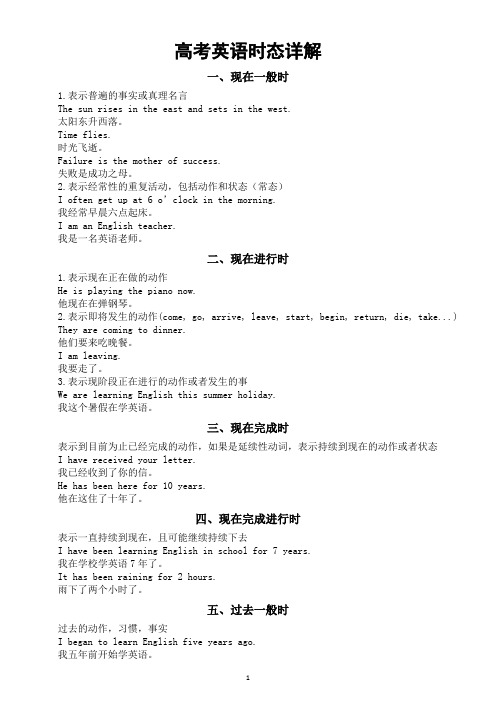
高考英语时态详解一、现在一般时1.表示普遍的事实或真理名言The sun rises in the east and sets in the west.太阳东升西落。
Time flies.时光飞逝。
Failure is the mother of success.失败是成功之母。
2.表示经常性的重复活动,包括动作和状态(常态)I often get up at 6 o’clock in the morning.我经常早晨六点起床。
I am an English teacher.我是一名英语老师。
二、现在进行时1.表示现在正在做的动作He is playing the piano now.他现在在弹钢琴。
2.表示即将发生的动作(come, go, arrive, leave, start, begin, return, die, take...) They are coming to dinner.他们要来吃晚餐。
I am leaving.我要走了。
3.表示现阶段正在进行的动作或者发生的事We are learning English this summer holiday.我这个暑假在学英语。
三、现在完成时表示到目前为止已经完成的动作,如果是延续性动词,表示持续到现在的动作或者状态I have received your letter.我已经收到了你的信。
He has been here for 10 years.他在这住了十年了。
四、现在完成进行时表示一直持续到现在,且可能继续持续下去I have been learning English in school for 7 years.我在学校学英语7年了。
It has been raining for 2 hours.雨下了两个小时了。
五、过去一般时过去的动作,习惯,事实I began to learn English five years ago.我五年前开始学英语。
高考英语复习谓语动词时态语态课件

时态体现在句子的谓语动词 语态:主动语态、被动语态 主动语态表示主语是动作的执行者。 They built a bridge over the river. 被动语态表示主语是动作的承受者。 A bridge was built over the river (by them).
number of areas that w__e_re_ (be) previously unprotected, bringing many of the existing protected areas for giant pandas under one authority to increase effectiveness and reduce inconsistencies in management.
3.(2022·新高考Ⅱ卷)Henry _w__as__fi_x_in_g___ (fix) his car when he heard the screams. 4.(2022·全国甲卷)In the last five years, Cao _h_a_s__w_a_lk_e_d__ (walk) through
12.in/over the last/past5 years在过去的5年时间里
表示在过去某一时刻或动作之前已经完成的动作,即 “过去的过去”;通常以一般过去时作参照。
past A B now
future
过去完成时 一般过去时 句中常含有:by/before+过去, by last year, by the end of 1998, by the time +过去
11.at the age of 5
高考英语时态知识点

高考英语时态知识点一、一般现在时一般现在时表示经常性或习惯性的动作、状态或真理。
1. 结构:主语 + 动词原形(第三人称单数动词需加-s/-es)+ 其他成分2. 示例:He usually plays football on weekends. 他通常周末踢足球。
They live in London. 他们住在伦敦。
3. 使用场景:a) 经常性或习惯性动作:I always go to the gym in the morning. 我每天早上都去健身房。
b) 真理:The sun rises in the east. 太阳从东方升起。
二、一般过去时一般过去时表示过去某个时间发生的动作或存在的状态。
1. 结构:主语 + 动词过去式(第三人称单数需加-ed/-d)+ 其他成分2. 示例:She studied English literature at university. 她在大学期间学习英国文学。
They visited their grandparents last summer. 他们去年夏天拜访了他们的祖父母。
3. 使用场景:a) 过去某个时间的动作:We went to the cinema last night. 昨晚我们去看电影了。
b) 过去存在的状态:The city was very crowded during the holiday. 假期期间这个城市非常拥挤。
三、一般将来时一般将来时表示将要发生的动作或存在的状态。
1. 结构:主语 + will/shall + 动词原形 + 其他成分2. 示例:I will visit my grandparents next month. 下个月我将去拜访我的祖父母。
She won't go to the party tonight. 今晚她不会去参加派对。
3. 使用场景:a) 将要发生的动作:They will arrive at the airport in two hours. 他们将在两小时内到达机场。
高考英语时态语态知识点

高考英语时态语态知识点一、时态知识点1. 一般现在时一般现在时表示经常性或习惯性的动作、状态或客观真理等。
例句:Water boils at 100 degrees Celsius.2. 一般过去时一般过去时表示过去某个时间发生的动作或存在的状态。
例句:She lived in London for five years.3. 一般将来时一般将来时表示将来某个时间即将发生的动作或存在的状态。
例句:I will finish my homework tomorrow.4. 现在进行时现在进行时表示现在正在进行的动作。
例句:They are watching a movie right now.5. 过去进行时过去进行时表示过去某个时间正在进行的动作。
例句:She was studying when I called her.6. 将来进行时将来进行时表示将来某个时间正在进行的动作。
例句:This time next week, we will be traveling in Japan.7. 现在完成时现在完成时表示过去某个时间发生的动作对现在造成的影响或结果。
例句:I have finished my homework.8. 过去完成时过去完成时表示过去某个时间或动作之前已经发生的动作或存在的状态。
例句:She had already left when I arrived.9. 将来完成时将来完成时表示将来某个时间之前已经完成的动作或存在的状态。
例句:By this time tomorrow, I will have finished my report.二、语态知识点1. 主动语态主动语态表示主语是动作的执行者。
例句:She wrote a letter.2. 被动语态被动语态表示主语是动作的承受者,强调动作对主语的影响。
例句:The letter was written by her.3. 进行时的被动语态进行时的被动语态表示主语正在被动地进行某个动作。
高三英语复习:时态语态课件(共10张PPT)

将来进行时 will/shall be doing will/shall be being done
现在完成时
过去完成时 现在完成进行
时
have/has done had done
have/has been done had been done
have/has been doing
• 不同时态变被动的规律总结:
(2)结尾是s, x, sh, ch, o,前为辅音字母,结尾加es :
• watch— ___________ teach—___________
• go— ___________
do— __________
• wash— ___________
cross— ___________
• mix— __________
at a young age, during the trip, on my previous visits, on April 4, 2016, last night, at the last minute, 表示过 去一段时间内经常发生的或习惯性的动作 第44题 其他根据并列动词时态
固定句式: since 句式 第32,38,40,共3题。 被动语态: 第33,34,35,36,37,41,54,共7题。 不规则动词: 第30,32,33,44,54,共5题
• 保留原来时态中助(will/shall/would/am/is/ are/was/were/has/have/had),把be动词变 为原来时态中do的形式,再加动词的过去分词。
对动词时态语态考察形式的总结:
• 一般现在时:1-14题 • (1)表示现在的状态或经常、反复、习惯性的
动作。 第3题,共1题 (2)表示客观事实或普遍真理。 第1,2,5,6,14,共5题 (3)主将从现 第4,9,10,11,12,13,共5题
动词的时态和语态-2025年高考英语一轮复习参考答案

动词的时态和语态时态:时态主动被动一般现在时do/does; am/is/are am/is/are done一般过去时did; was/were was/were done 一般将来时will/shall do will/shall be done过去将来时would/should dowas/were going to dowas/were(about)to dowould/should be donewas/were going to be donewas/were(about)to be done现在进行时am/is/are doing am/is/are being done过去进行时was/were doing was/were be ing done将来进行时will/shall be doing现在完成时have/has done have/has been done过去完成时had done had been done将来完成时will have done will have been done2.必备知识考点一一般时知识点1一般现在时1.表示经常性的动作,常与usually,always,often,sometimes,never,every day等表示频度的时间状语连用。
2.表示客观真理、格言或者警句等。
3.表示按规定、时间表、计划或安排要发生的动作。
动词come, go, arrive, leave, start, begin, return, live, fly等,常用一般现在时表示将来发生的动作。
4.在时间、条件等状语从句中常用一般现在时代替一般将来时。
5.以here/there开头引导的倒装句,表示正在发生的动作/状态6.用于文章标题、图片说明、电影说明、戏剧内容及场景解说等。
知识点2一般过去时1. 表示在过去发生的一次性动作或习惯性动作或存在的状态,常用yesterday,last year,in 1995,the other day等作时间状语。
高中16种英语时态总结归纳表格
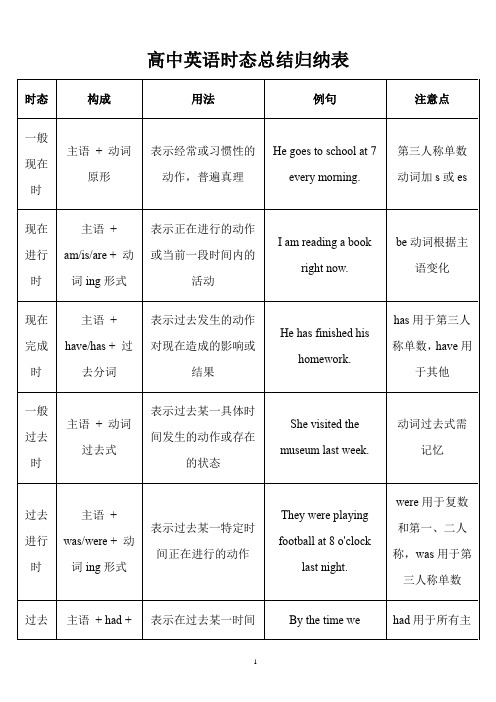
-
过去将来完成时
主语+ would have +过去分词
表示从过去某一时间看将来某一时间点之前已经完成的动作
He said by the time we arrived, he would have finished his homework.
be动词根据主语变化
现在完成时
主语+ have/has +过去分词
表示过去发生的动作对现在造成的影响或结果
He has finished his homework.
has用于第三人称单数,have用于其他
一般过去时
主语+动词过去式
表示过去某一具体时间发生的动作或存在的状态
She visited the museum last week.
By 2025, I will have been working here for 10 years.
-
-
一般过去将来时
主语+ woபைடு நூலகம்ld +动词原形
表示从过去某一时间看将要发生的动作或状态
He said he would visit the museum the next day.
would是will的过去式
过去将来进行时
主语+ would be +动词ing形式
表示从过去某一时间看将来某一特定时间正在进行的动作
将来进行时
主语+ will be +动词ing形式
表示将来某一特定时间正在进行的动作
This time next week, I will be lying on the beach.
熟练掌握英语16大时态讲义-2024届高考英语一轮复习
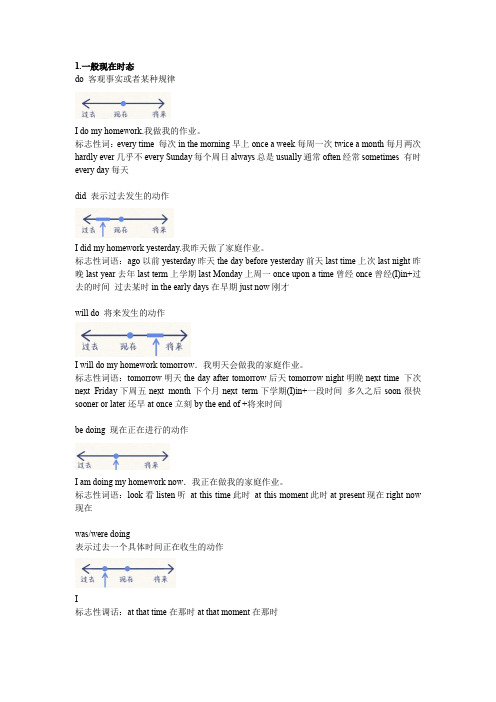
1.一般现在时态do 客观事实或者某种规律I do my homework.我做我的作业。
标志性词:every time 每次in the morning早上once a week每周一次twice a month每月两次hardly ever几乎不every Sunday每个周日always总是usually通常often经常sometimes 有时every day每天did 表示过去发生的动作I did my homework yesterday.我昨天做了家庭作业。
标志性词语:ago以前yesterday昨天the day before yesterday前天last time上次last night昨晚last year去年last term上学期last Monday上周一once upon a time曾经once曾经(I)in+过去的时间过去某时in the early days在早期just now刚才will do 将来发生的动作I will do my homework tomorrow.我明天会做我的家庭作业。
标志性词语:tomorrow明天the day after tomorrow后天tomorrow night明睌next time 下次next Friday下周五next month下个月next term下学期(I)in+一段时间多久之后soon很快sooner or later还早at once立刻by the end of +将来时间be doing 现在正在进行的动作I am doing my homework now.我正在做我的家庭作业。
标志性词语:look看listen听at this time此时at this moment此时at present现在right now 现在was/were doing表示过去一个具体时间正在收生的动作I标志性调话:at that time在那时at that moment在那时will be doing在将来正在发生的动作I will be doing my homework at 9:00.9点的时候,我会正在政作业。
高三英语 时态和语态复习 (共53张PPT)

2)表示在过去一段时间内,经常性或习惯性的动作。 When I was a child, I often played football in the street.
现在完成时
构成: have (has) +过去分词。
现在完成时常与一些时间状语连用, 如: already; yet; just; before; recently ; lately ;等。
1)表示动作发生在过去,但对现在有影响。如:
I have just come back from America.
The leaves are turning red. It's getting warmer and warmer.
c. 与always, constantly, forever 等词连用,表示反 复发生的动作或持续存在的状态,往往带有说话人 的主观色彩。
You are always changing your mind.
用于现在完成时的句型 1)It is the first / second time….the only--- that…结构中的
从句部分,用现在完成时。 It is the first time that I have visited the city. It is the only detective novel that I have ever read. 2)This is the… that…结构,that 从句要用现在完成时. This is the best film that I've (ever) seen. 这是我看过的最好的电影。
高考英语时态知识大全汇总

高考英语时态知识大全汇总时态在英语中扮演着非常重要的角色,准确使用时态能够帮助我们清晰地表达自己的意思,因此在高考英语考试中也是一个重要的知识点。
下面是高考英语时态知识的详细介绍。
一、一般现在时一般现在时表示经常性的、习惯性的动作、事实或者真理。
结构:主语 + 动词原形(第三人称单数加s或es)1. 表示经常性的动作或习惯例句:I always get up early in the morning.I often go to the park on weekends.2. 表示客观真理或普遍规律例句:The sun rises in the east.Water boils at 100 degrees Celsius.二、一般过去时一般过去时表示过去某个时间发生的动作或存在的状态。
结构:主语 + 动词的过去式1. 表示过去发生的某个具体动作例句:Yesterday, I went to the cinema with my friends.They visited their grandparents last week.2. 表示过去的某个状态或习惯性动作例句:He used to swim every day when he was young.She lived in London for five years.三、一般将来时一般将来时表示将来某个时间会发生的动作或存在的状态。
结构:主语 + will + 动词原形1. 表示未来发生的某个具体动作例句:I will visit my grandparents next week.She will go shopping tomorrow.2. 表示预测、打算或意愿例句:I think it will rain tonight.They will have a party to celebrate their anniversary.四、现在进行时现在进行时表示正在进行的动作。
高考英语动词时态语态复习课件

be going to 有很强的计划性;打算干什么;而will表示谈 话时临时决定的意图;具有临时性和偶然性
① The telephone is ringing I _____ answer it
√A. will B am going to C am to D am about to
② Alice; why didn’t you come yesterday
3 用一般过去时表示过去经常发生的动作 也可用 used to do或 would do 代替 During the vacation I often swam /
would swim / used to swim in the sea 假期期间我常在大海里游泳
I used ur daily life as a high school student
using 3 sentences or more;使用实意动词 和系动词; 注意动词形式变化
一 一般现在时 The Simple Present tense
1 结构: do/does
2 用法: 1 经常性或习惯性的动作;常与表示频率 的时间状语连用;如often; usually; always; every day/year; sometimes; on Sunday等
My family have lived in Zhuhai for 10 years 目前还在珠海
2 过去时常与具体的表示过去的时间状语连用;而 现在完成时通常与不确定的或包括现在在内的时 间状语连用;或无时间状语
I study hard every day and I get along well with my classmates; but sometimes I miss my families
2023届高三英语一轮复习谓语动词的时态和语态复习讲义
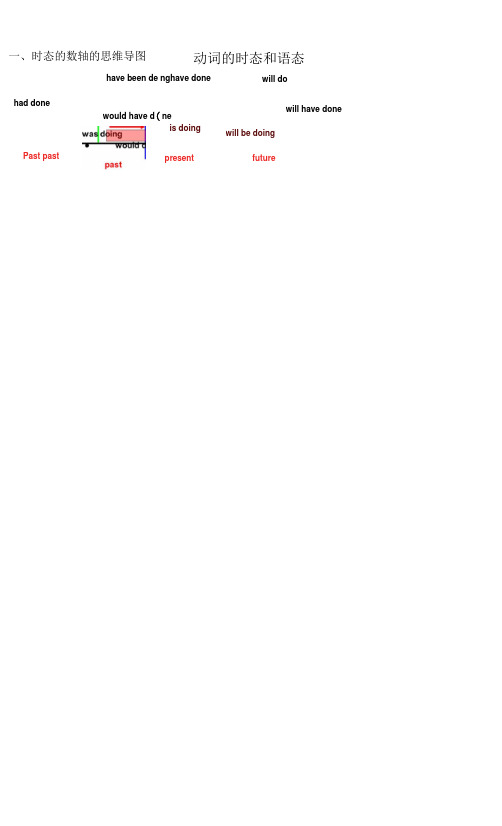
一、时态的数轴的思维导图have been de nghave done动词的时态和语态will do had donewill have done Past pastis doingpresentwill be doing future would have d ( ne考点一、现在时一、一般现在时1.含义1)经常性或习惯性的动作,常与表示频率的时间状语连用。
I leave home fbr school at 7 every morning.2)客观真理,客观存在,科学事实。
The earth moves around the sun.Shanghai lies in the cast of China.3)现在时刻的状态、能力、性格、个性。
Ann Wang writes good English but does not speak well.4) not....until....as...hen, before, after, not....until....等)、条件状语从句(if, unless, as long as...)中常用一般现在时表示将来Anything will become boring if you do it repetitively.As long as it doesn't rain tomorrow ,we will have a trip on schedule.2.常用的时间状语频率副词:often, usually, sometimes, always, seldom, hardly, never2)短语:every (day 等),once/twice a (week 等),on (Sunday 等),in the (morning 等),at (eight) , now and then, from time to timeHe usually goes to school by bike.3.谓语切词形式:do/does.谓语动词的被动语态:am/is/are doneIn the spoken English of some areas in the U.S, the " r" sounds at the end of the words arc dropped.练习:用所给单词的适当形式填空How close parents are to their children(have) a strong influence on the development of the children's characters.1.If your call is not answered within two minutes, you(advise) to hang up and dial again.2.We will be losing money this year unless that new economic plan of yours(work) miracle.3.It(turn) out that making a plan is easier than carrying it out.4.The growth of part-time and flexible working patterns, and of training and retraining schemes, (allow) more women to take advantage of employment opportunities.二、现在进行时.定义1)表示说话时正在进行的动作及行为;2)表示现阶段(近段时间)正在进行的动作。
高考英语科目必考知识点整理
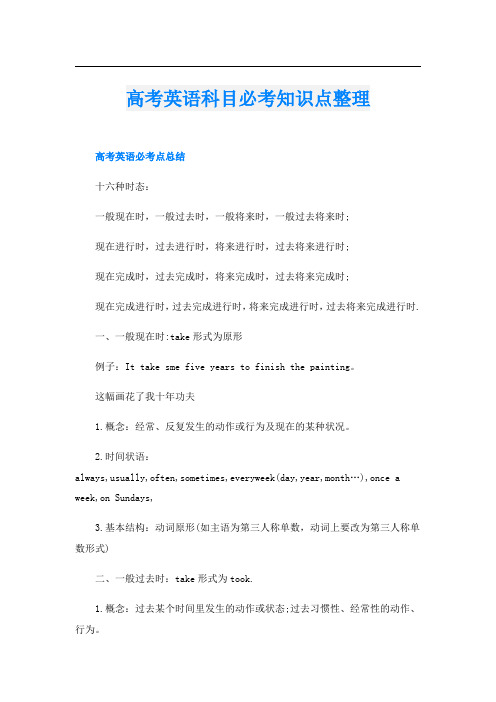
高考英语科目必考知识点整理高考英语必考点总结十六种时态:一般现在时,一般过去时,一般将来时,一般过去将来时;现在进行时,过去进行时,将来进行时,过去将来进行时;现在完成时,过去完成时,将来完成时,过去将来完成时;现在完成进行时,过去完成进行时,将来完成进行时,过去将来完成进行时.一、一般现在时:take形式为原形例子:It take sme five years to finish the painting。
这幅画花了我十年功夫1.概念:经常、反复发生的动作或行为及现在的某种状况。
2.时间状语:always,usually,often,sometimes,everyweek(day,year,month…),once a week,on Sundays,3.基本结构:动词原形(如主语为第三人称单数,动词上要改为第三人称单数形式)二、一般过去时:take形式为took.1.概念:过去某个时间里发生的动作或状态;过去习惯性、经常性的动作、行为。
2.时间状语:ago,yesterday,the day beforeyesterday,lastweek,last(year,night,month…),in1989,just now,at the age of 5,one day,long long ago,once up on a time,etc.3.基本结构:be动词;行为动词的过去式三、现在进行时:take形式为am/is/are taking1.概念:表示现阶段或说话时正在进行的动作及行为。
2.时间状语:now,at this time,these days,etc.3.基本结构:am/is/are+doing四、过去进行时:take形式为was/were+taking1.概念:表示过去某段时间或某一时刻正在发生或进行的行为或动作。
2.时间状语:at this time yesterday,at that time或以when引导的谓语动词是一般过去时的时间状语等。
高中英语常用时态
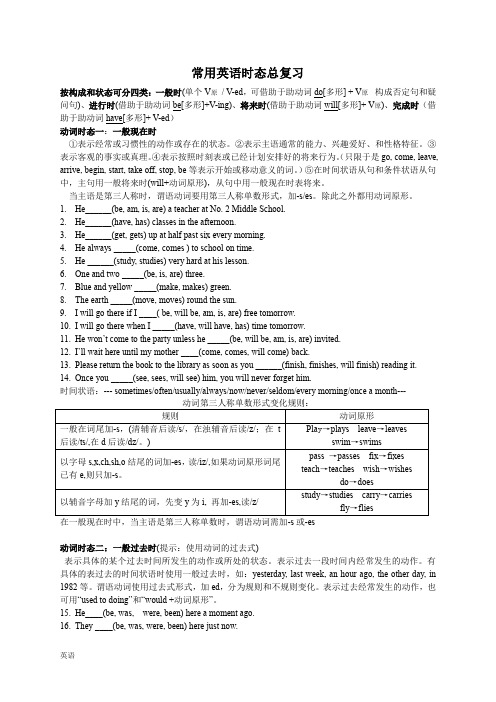
常用英语时态总复习按构成和状态可分四类:一般时(单个V原/ V-ed,可借助于助动词do[多形] + V原构成否定句和疑问句)、进行时(借助于助动词be[多形]+V-ing)、将来时(借助于助动词will[多形]+ V原)、完成时(借助于助动词have[多形]+ V-ed)动词时态一:一般现在时①表示经常或习惯性的动作或存在的状态。
②表示主语通常的能力、兴趣爱好、和性格特征。
③表示客观的事实或真理。
④表示按照时刻表或已经计划安排好的将来行为。
(只限于是go, come, leave, arrive, begin, start, take off, stop, be等表示开始或移动意义的词。
)⑤在时间状语从句和条件状语从句中,主句用一般将来时(will+动词原形),从句中用一般现在时表将来。
当主语是第三人称时,谓语动词要用第三人称单数形式,加-s/es。
除此之外都用动词原形。
1.He______(be, am, is, are) a teacher at No. 2 Middle School.2.He______(have, has) classes in the afternoon.3.He______(get, gets) up at half past six every morning.4.He always _____(come, comes ) to school on time.5.He ______(study, studies) very hard at his lesson.6.One and two _____(be, is, are) three.7.Blue and yellow _____(make, makes) green.8.The earth _____(move, moves) round the sun.9.I will go there if I ____( be, will be, am, is, are) free tomorrow.10.I will go there when I _____(have, will have, has) time tomorrow.11.He won’t come to the party unless he _____(be, will be, am, is, are) invited.12.I’ll wait here until my mother ____(come, comes, will come) back.13.Please return the book to the library as soon as you ______(finish, finishes, will finish) reading it.14.Once you _____(see, sees, will see) him, you will never forget him.时间状语:--- sometimes/often/usually/always/now/never/seldom/every morning/once a month---动词时态二:一般过去时(提示:使用动词的过去式)表示具体的某个过去时间所发生的动作或所处的状态。
高中英语动词时态语态讲解

1、一般现在时主要用来表示人、事物的现在状况和特点;表示经常或习惯性的动作,句子中常有often, always, from time to time 等时间状语;表示客观规律和永恒真理等。
He usually goes to work at 7 o’clock every morning.The earth goes around the sun.Guangzhou is situated in the south of China.考点一:表示永恒的真理,即使出现在过去的语境中,仍用一般现在时。
如:I learned that the earth goes around the sun when I was in primary school.考点二:在时间和条件状语从句中,代替一般将来时;常用的引导词有:时间:when, until, after, before, as soon as, once, the moment/the minute, the day; 条件:if, unless, provided.If he accepts the job, he will get more money soon.考点三:在make sure (certain), see to it, mind, care, matter +宾语从句,从句用一般现在时代替一般将来时。
So long as he works hard, I don’t mind when he finishes the experiment.只要他努力工作,我不介意他什么时候做完试验。
考点四:在the more… the more … (越…越…) 句型中, 若主句是一般将来时, 从句通常用一般现在时。
The harder you study, the better results you will get.2、现在进行时表说话时或目前一段时间内正在进行的活动:或表感情色彩,加强语气。
- 1、下载文档前请自行甄别文档内容的完整性,平台不提供额外的编辑、内容补充、找答案等附加服务。
- 2、"仅部分预览"的文档,不可在线预览部分如存在完整性等问题,可反馈申请退款(可完整预览的文档不适用该条件!)。
- 3、如文档侵犯您的权益,请联系客服反馈,我们会尽快为您处理(人工客服工作时间:9:00-18:30)。
6,现在完成时的用法
(1)表示刚刚完成的动作,常与just 连用. 表示刚刚完成的动作,常与just 连用. (2)表示过去发生而持续到现在的动作或状态,甚至延续 表示过去发生而持续到现在的动作或状态, 到将来.常与since, 连用, since不能与 到将来.常与since, for 连用,但for, since不能与 终止性的动词连用. 终止性的动词连用. (3)表示过去的动作对现在造成的影响或结果. 表示过去的动作对现在造成的影响或结果. In the past two years, the students in the mountainous areas have made great progress in English. He has visited 14 foreign countries so far. They have lived in Beijing since 1995. I have learned English for ten years. This is my first time that I have visited China. That is the only book that he has written. seen. This is the most interesting film I have ever seen
8,现在完成时的用法
(1)由"have (has)+ been+现在分词"构成,表示现在以前 been+现在分词"构成, 现在分词 一直在进行的动作,强调动作的"未完成性" 一直在进行的动作,强调动作的"未完成性". (2)少数动词如 live, teach, work, study, wait, lie 等 表示可以长时间持续的动作,用完成时或完成进行时都可以, 表示可以长时间持续的动作,用完成时或完成进行时都可以, 意义差别不大. 意义差别不大. Now that she is out of a job, Lucy has been Considering going back to school, but she hasn't decided yet. I have studied ( have been studying ) English for a long time.
9,将来进行时
主要表示将来某时刻正在进行的动作. 主要表示将来某时刻正在进行的动作.在口语中常用来 表示预计即将发生或势必要发生的动作. 表示预计即将发生或势必要发生的动作.这一时态和一般将 来时只有细微的差别,有时在口气上则没有差别,可以互换. 来时只有细微的差别,有时在口气上则没有差别,可以互换.
I will come (will be coming) here on time next Mondays. Mondays由 shall ( will ) have 加过去分词构成,主要表示将来 某时段已发生的事情,这个时态有时用来表示一种推测. 某时段已发生的事情,这个时态有时用来表示一种推测.如: We worked together for a year. He won't have (大概不会忘记 大概不会忘记) Forgotten me. (大概不会忘记) The mayor of Beijing says that all construction Work for the conference will have been completed By 2010. He will have gone to Shanghai when you arrive Tomorrow afternoon.
(2)如果从句中的谓语动词所表示的动作发生在主句谓语 ) 动词所表示的动作之前,从句须用过去完成时. 动词所表示的动作之前,从句须用过去完成时.如: I didn't know that she had been to London twice. (3)如果从句中的谓语动词所表示的动作发生在主句谓语 ) 动词所表示的动作之后,从句须用过去将来时. 动词所表示的动作之后,从句须用过去将来时.如: They didn't know when they would have a rest . (4)如果从句中说明的是一种普遍真理现象,虽然主句的 )如果从句中说明的是一种普遍真理现象, 谓语动词为过去时态,从句中仍要用一般现在时. 谓语动词为过去时态,从句中仍要用一般现在时.如: When I was a little child, my father told me that the earth is round. (5)如果从句中有表示具体过去时间的状语,虽然其谓语 )如果从句中有表示具体过去时间的状语, 动词所表示的动作发生在主句谓语动词所表示的动作之前, 动词所表示的动作发生在主句谓语动词所表示的动作之前,从 句仍用一般过去时;但如果该状语表示的时间不具体, 句仍用一般过去时;但如果该状语表示的时间不具体,则从句 仍要用过去完成时. 仍要用过去完成时.如: Tome said he was born in 1975.
2,一般过去时的用法
(1)表示过去的动作或状态. 表示过去的动作或状态. (2)叙述过去连续发生的事情. 叙述过去连续发生的事情. (3)表示过去一段时间内经常发生的动作. 表示过去一段时间内经常发生的动作. He used to smoke a lot. He has got used to getting up early. He promised to buy me a computer if he got a raise. I never thought you were going to bring me a gift.
4,现在进行时的用法
(1)表示说话的时候正在进行的动作. 表示说话的时候正在进行的动作. (2)表示先阶段正在进行的动作.(说话时动作不一定进行) 表示先阶段正在进行的动作.(说话时动作不一定进行) .(说话时动作不一定进行 We are having English class. The house is being built these days. The little boy is always making trouble. Don't wake him up if he is still sleeping at 7 Tomorrow morning. Florida. I am taking my mom. Look out when you are crossing the street. I've won a holiday for two days to Florida. I am taking my mom.
1,一般现在时的用法
(1)表示现在的习惯,经常发生的动作或存在的状态. 表示现在的习惯,经常发生的动作或存在的状态. (2)表示助于的特征,性格和能力. 表示助于的特征,性格和能力. 助于的特征 (3)表示客观事实或真理. 表示客观事实或真理. (4)表示按照计划安排好的将来行为.(只限于是go, come, 表示按照计划安排好的将来行为.(只限于是go, .(只限于是 be等开始或移动意义的词 等开始或移动意义的词) leave, start, stop, be等开始或移动意义的词)如: She has a brother who lives in New York. The earth goes around the sun. Guangzhou is situated in the south of China. I learned that the earth goes around the sun when I was in primary school. So long as he works hard, I don't mind when he finishes the experiment.
3,一般将来时的用法
(1)表示将来的动作或状态. 表示将来的动作或状态. (2)表示将来的经常性动作. 表示将来的经常性动作.
We will begin our class as soon as the teacher comes. I am leaving for Beijing tomorrow. Use your head and you will find a way. He is going to visit his aunt the moment he arrives. I am about to leave when the telephone rings. The medicine is to be taken three times a day.
5,过去进行时的用法
(1)过去某一时刻或某一段时间内正在进行的动作 1 go等词 (2)表示移动的动词:come, start, stay, leave, go等词 表示移动的动词: 的过去进行时可以表示过去的将来要发生的动作. 的过去进行时可以表示过去的将来要发生的动作. (3)was going to do 可以表示在过去某一时间之后 发生的动作 The boy was doing his homework when his father came back from work. He was taking a walk leisurely by the lake when he heard some one shouted for help. What were you doing at nine last night? I first met Lisa 3 years ago. She was working at a radio shop at the time. --Hey, --Hey, look. Where are you going! --Oh, --Oh, I am terribly sorry. I wasn't noticing.
